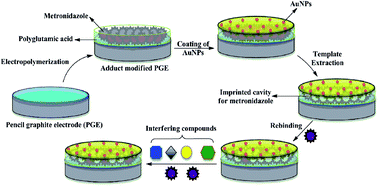A metronidazole-probe sensor based on imprinted biocompatible nanofilm for rapid and sensitive detection of anaerobic protozoan†
Abstract
A novel and simple molecularly imprinted polymer (MIP) based electrochemical sensor is developed for indirect detection of anaerobic protozoans (Entamoeba histolytica and Giardia lamblia) using metronidazole (MDZ) as an electroactive probe molecule. Before electropolymerization, a computational approach was applied to screen functional monomers and polymerization solvents for rational design of a MDZ selective MIP. Based on the theoretical calculations, glutamic acid and water were found to be the best functional monomers and solvent for polymerization, respectively. A thin film of polyglutamic acid along with gold nanoparticles and MDZ was cast onto the surface of a pencil graphite electrode by cyclic voltammetry method for the fabrication of the electrochemical sensor. Surface morphology of the MDZ-imprinted polymer modified electrode was analyzed with a scanning electron microscope, whereas cyclic voltammetry, chronocoulometry and differential pulse stripping voltammetry were performed for qualitative and quantitative analysis of MDZ. The MDZ-imprinted sensor presented a linear response to MDZ in the concentration range from 9.87 ng L−1 to 130.0 mg L−1 with a limit of detection of 1.0 ng L−1 (S/N = 3). The MDZ-selective sensor was further successfully applied to the determination of anaerobic protozoans and showed high sensitivity and reproducibility (liner range from 1.6 to 1.6 × 107 CFU mL−1 with a detection limit of 2.0 CFU mL−1). The research in this study has offered a rapid, accurate and sensitive electrochemical method for quantitative determination of MDZ as well as anaerobic protozoans in a single format.


 Please wait while we load your content...
Please wait while we load your content...